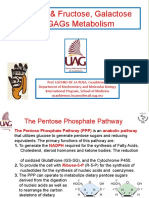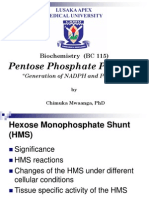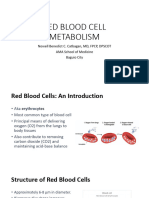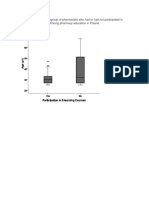Anaerobic Metabolism of Carbohydrates in RBC - Lectue XXI
Anaerobic Metabolism of Carbohydrates in RBC - Lectue XXI
Uploaded by
SaulCopyright:
Available Formats
Anaerobic Metabolism of Carbohydrates in RBC - Lectue XXI
Anaerobic Metabolism of Carbohydrates in RBC - Lectue XXI
Uploaded by
SaulOriginal Description:
Copyright
Available Formats
Share this document
Did you find this document useful?
Is this content inappropriate?
Copyright:
Available Formats
Anaerobic Metabolism of Carbohydrates in RBC - Lectue XXI
Anaerobic Metabolism of Carbohydrates in RBC - Lectue XXI
Uploaded by
SaulCopyright:
Available Formats
TBL : Glucose 6-phosphate dehydrogenase (G6PD)
Glucose-6-phosphate dehydrogenase (G6PD) deficiency is the most
common enzymopathy worldwide, affecting an estimated 400 million
people. The major morbidity associated with G6PD deficiency is
hemolytic anemia, which in some individuals may be life-
threatening. G6PD deficiency leads to inadequate production of
protective intracellular thiols during oxidative stress. While the
deficiency is ubiquitous across cell types, erythrocytes are reduced
oxidized
particularly vulnerable to oxidative stress in the G6PD-deficient glutathione
glutathione
state. Bubp, et al., Pharmacy & Therapeutics, 40(9): 572–574
Question 1. How does G6PD deficiency lead to hemolytic anemia?
Lack of G6PD would lead to decreased glucose 6-phosphate in the pentose phosphate
pathway, which would ultimately lead to decreased NADPH. Production of NADPH by
G6PD is essential in erythrocytes, which are susceptible to damage by reactive oxygen
species because they lack other NADPH-producing enzymes.
Question 2. Why are erythrocytes more vulnerable to oxidative stress
in the G6PD-deficient state?
In erythrocytes, there are no mitochondria leading to anaerobic conditions. This, in turn,
prevents NADH from being re-oxidized by O2, which forces NAD+ to be generated by
reduction of pyruvate to lactate (fermentation).
TBL : synthesis of of 2,3-bis phosphoglycerate (2,3-BPG)
2,3-BPG is an important by-product of glycolysis in the
RBC. It is synthesized through the conversion of 1,3-
BPG to 2,3-BPG catalyzed by 2,3-BPG mutase which
also has a phosphatase activity. Therefore the enzyme
controls both synthesis and hydrolysis of 2,3-BPG.
Question 1. Which reaction of glycolysis is bypassed
during the synthesis of 2,3-BPG?
Bypasses the conversion of 1,3-BPG to 3-PPG
Question 2. How does synthesis of 2,3-BPG affect the
energy yield of glycolysis?
Synthesis of 2,3-BPG reduces production of energy in glycolysis
Question 3. what is the role of 2,3-BPG in
erythrocytes?
2,3-BPG is used to produce 3-PPG through 2,3-BPG phosphatase. 3-PPG then is used to form pyruvate after several steps, which can then form lactate and
generate NADH. Conversion of hemoglobin from R state to T state and can release oxygen more easily. Higher level of oxygen produces more 2,3-BPG
which can reduce affinity of hemoglobin for oxygen, which can release oxygen more easily and travel to tissues.
TBL : Regulation of glycolysis
The flux of glucose through the glycolytic pathway is regulated to maintain nearly constant ATP levels.
Therefore, glycolysis is under tight regulation.
Question 1. Discuss the effects of the following factors on the rate of glycolysis:
• ATP consumption
• NADH regeneration
ATP Consumption = Leads to increased rate of glycolysis due to accommodate decreased concentration of ATP
present
NADH Regeneration = Leads to decreased rate of glycolysis since pathway does not need to work hard to produce
more NADH
Question 2. Predict the effects of allosteric regulation of the following enzymes by ATP on the rate of glycolysis:
• Hexokinase
• PFK-1
• Pyruvate kinase
Hexokinase = Allosterically bind to enzymes and lower rate of glycolysis (if ATP levels are high, decreased glycolysis)
PFK-1 = Allosterically bind to enzymes and lower rate of glycolysis
Pyruvate kinase = Allosterically bind to enzymes and lower rate of glycolysis
TBL : Rate of glycolysis and pentose phosphate pathways in tumors
Cancer cells undergo a metabolic switch from oxidative phosphorylation to glycolysis. The majority of
cancer cells depend on high rates of glycolysis for growth and survival, even when there is sufficient
oxygen. This type of aerobic glycolysis is called the Warburg effect. Yu, et al., Journal of cancer, 2017; 8(17): 3430- 3440
Question. Discuss the possible explanations for tumor cells use of the glycolysis pathway.
• Faster way of producing ATP
◦Are in a rush and want to divide more, need more ATP, user glycolysis for that
• Dividing quickly
◦Need some molecules produced from glycolysis for their metabolic pathways to produce molecules needed for
tumor cells
• Need NADPH
◦NADPH protects cells against oxidative damage which cancer cells need too, especially against anti-cancer
drugs. It is a form of adaption against drugs that cause oxidative damage. Both glycolysis and pentose
phosphate pathways increase in tumor cells due to increased NADPH.
You might also like
- Biochemistry CasesTeenage Weakling 2015Document5 pagesBiochemistry CasesTeenage Weakling 2015Neel KotrappaNo ratings yet
- ParticipantCaseWorksheets 072018Document11 pagesParticipantCaseWorksheets 072018Saul0% (7)
- Biochem HomeworkDocument13 pagesBiochem Homeworkfcukingfranztastik50% (2)
- Lange Smart Charts: Pharmacology, 2e Medications Affecting Cardiac and Renal FunctionDocument2 pagesLange Smart Charts: Pharmacology, 2e Medications Affecting Cardiac and Renal FunctionSaulNo ratings yet
- L8 (9) WKSHT 13 Human Defence SystemsDocument4 pagesL8 (9) WKSHT 13 Human Defence SystemsBob BanterNo ratings yet
- Lintasan Pentosa FosfatDocument7 pagesLintasan Pentosa FosfatMUHAMMAD RIDONo ratings yet
- Pentose Phosphate PathwayDocument35 pagesPentose Phosphate PathwayRacheal MphandeNo ratings yet
- (3.19) CarbosMetab (PPP, Other Sugars & GAGs)Document74 pages(3.19) CarbosMetab (PPP, Other Sugars & GAGs)pamelaNo ratings yet
- Running Head: Glucose-6-Phosphate Dehydrogenase Deficiency 1Document4 pagesRunning Head: Glucose-6-Phosphate Dehydrogenase Deficiency 1migire kennedyNo ratings yet
- Hexose Monophosphate ShuntDocument38 pagesHexose Monophosphate ShuntJohn Raniel IsidroNo ratings yet
- EritrocitosYdefectos MetabolicosDocument10 pagesEritrocitosYdefectos Metabolicosandres herreraNo ratings yet
- PPP Non Oxidative Group 2Document23 pagesPPP Non Oxidative Group 2michaelkingtz01No ratings yet
- Assignment For Blood - PaysonDocument25 pagesAssignment For Blood - PaysonRodrigo Joseph PaysonNo ratings yet
- Carbo Meta, Glycolysis, Krebs Cycle, GluconeoDocument31 pagesCarbo Meta, Glycolysis, Krebs Cycle, GluconeoKellyNo ratings yet
- Note BiotechnologyDocument6 pagesNote BiotechnologyHala AlzuhairiNo ratings yet
- Lecture # 7 Pentose Phosphate PathwayDocument44 pagesLecture # 7 Pentose Phosphate PathwayDesy AnggrainiNo ratings yet
- Lecture # 7 Pentose Phosphate PathwayDocument46 pagesLecture # 7 Pentose Phosphate PathwayMaria Rozan JungNo ratings yet
- CHO Metabolism Part 3Document34 pagesCHO Metabolism Part 3QasmNo ratings yet
- Hexose Monophosphate ShuntDocument43 pagesHexose Monophosphate ShuntSecret Agent100% (1)
- Glycolysis: Shekhar Chandra Yadav Lecturer Dept. of BiochemistryDocument25 pagesGlycolysis: Shekhar Chandra Yadav Lecturer Dept. of BiochemistryTULSI SHARMANo ratings yet
- Carbo Meta, Glycolysis, Krebs Cycle, GluconeoDocument80 pagesCarbo Meta, Glycolysis, Krebs Cycle, GluconeoMoses MutsikwiNo ratings yet
- (CO8) Chemistry of VisionDocument7 pages(CO8) Chemistry of VisionCardoge DalisayNo ratings yet
- 3-HMP and Glucuronic Acid PathwaysDocument40 pages3-HMP and Glucuronic Acid Pathwayslou765500No ratings yet
- GlycolysisDocument15 pagesGlycolysisRakshitNo ratings yet
- CHE 311 Lecture 4 GlycolysisDocument28 pagesCHE 311 Lecture 4 Glycolysisisaac mwanzaNo ratings yet
- HMP Pathway: Hexose Mono Phosphate PathwayDocument25 pagesHMP Pathway: Hexose Mono Phosphate PathwayAyoubMuhammadNo ratings yet
- 5 Pentose Phosphate Pathway (HMP Shunt)Document19 pages5 Pentose Phosphate Pathway (HMP Shunt)ycqry9z2dgNo ratings yet
- 2.2 Pentose and Uronic PathwayDocument28 pages2.2 Pentose and Uronic PathwayYared gebremedhinNo ratings yet
- GlycolysisDocument10 pagesGlycolysiselowanegNo ratings yet
- Lecture 7 Pentosephosphate PathwayDocument35 pagesLecture 7 Pentosephosphate PathwayHawaid AhmadNo ratings yet
- Erythrocyte G6PD Activity and GSH Level As Risk Factors For Vascular Complications Among Type 2 Diabetics in Osogbo NigeriaDocument6 pagesErythrocyte G6PD Activity and GSH Level As Risk Factors For Vascular Complications Among Type 2 Diabetics in Osogbo NigeriaAudrey LyliNo ratings yet
- 3 GlycolysisDocument27 pages3 GlycolysisHammad KambohNo ratings yet
- Carbohydrate MetabolismDocument1 pageCarbohydrate MetabolismLakshmi VenkataramanNo ratings yet
- Lecture 5Document4 pagesLecture 5mohammed.riad.bi.2020No ratings yet
- HMP Pathway PDFDocument44 pagesHMP Pathway PDFHimanshu SharmaNo ratings yet
- Lec32 F08 HandoutDocument11 pagesLec32 F08 HandoutSarayu Ragavan NairNo ratings yet
- Biochemistry SidesDocument13 pagesBiochemistry SidesYousif KashatNo ratings yet
- 7 Glycolysis Notes GanapathyDocument16 pages7 Glycolysis Notes GanapathyAli Ali AliNo ratings yet
- Glucose Metabolism An Overview Nov2010Document29 pagesGlucose Metabolism An Overview Nov2010Gashaw FisehaNo ratings yet
- Red Blood Cell Metabolism BiochemistryDocument20 pagesRed Blood Cell Metabolism BiochemistrynonoybenedictNo ratings yet
- 2.glycolysis & Oxidation of PyruvateDocument12 pages2.glycolysis & Oxidation of Pyruvateقتيبه خالد دحام خلفNo ratings yet
- Echevarria Jonille S BSP 2Document6 pagesEchevarria Jonille S BSP 2Jonille EchevarriaNo ratings yet
- 9 Lec. Biochemistry (4th)Document18 pages9 Lec. Biochemistry (4th)Doctor SonuNo ratings yet
- HMP ShuntDocument14 pagesHMP Shuntامجد حسين جواد كاظمNo ratings yet
- Biochem2-Week 3-Glycolysis-Gluconeogenesis-PPPDocument49 pagesBiochem2-Week 3-Glycolysis-Gluconeogenesis-PPPBùi Ngọc MaiNo ratings yet
- Nucleic Acid FultonDocument21 pagesNucleic Acid FultonMicky Amekan100% (1)
- GlycolysisDocument35 pagesGlycolysisAastha SinhaNo ratings yet
- The Pentose Phosphate Pathway in Health and Disease: Nature MetabolismDocument15 pagesThe Pentose Phosphate Pathway in Health and Disease: Nature Metabolismliliana-contrerasNo ratings yet
- Biochemistry: Questions & AnswersDocument14 pagesBiochemistry: Questions & AnswersA-Naeem To'mah Al-sawaieNo ratings yet
- 2023-2024-B3502-Lecture 17-Carbohydrate Metabolism-Gluconeogenesis and Oxidative Pentose Phosphate PathwayDocument15 pages2023-2024-B3502-Lecture 17-Carbohydrate Metabolism-Gluconeogenesis and Oxidative Pentose Phosphate Pathwaypitsolerato60No ratings yet
- g6pd - An Old Bottle With New WineDocument7 pagesg6pd - An Old Bottle With New Winecutegal88No ratings yet
- Glycolysis-StryerDocument36 pagesGlycolysis-StryerAngelikaOdimerNo ratings yet
- Biochem Compr RevisionDocument8 pagesBiochem Compr Revisionnyabuti300No ratings yet
- 5 Carbohydrate Metabolism IIIDocument3 pages5 Carbohydrate Metabolism IIILinus LiuNo ratings yet
- GlycolysisDocument31 pagesGlycolysisrafea_naffa8326No ratings yet
- Class Notes HMP Shunt Path WayDocument18 pagesClass Notes HMP Shunt Path WayShivanand MaliNo ratings yet
- Glucose-6-Phosphate Dehydrogenase (G6PD) Deficiency: Review ArticleDocument18 pagesGlucose-6-Phosphate Dehydrogenase (G6PD) Deficiency: Review Articlerena kurniaNo ratings yet
- Mason 2007Document17 pagesMason 2007CamilaNo ratings yet
- مؤمل جميل 2Document6 pagesمؤمل جميل 2مؤمل جميل حطابNo ratings yet
- Deficit de G6PD Who Working GroupDocument11 pagesDeficit de G6PD Who Working Groupvera dobreNo ratings yet
- Carbohydrate MetabolismDocument57 pagesCarbohydrate MetabolismYulliza Kurniawaty L100% (1)
- Glycolysis 3MDDocument48 pagesGlycolysis 3MDgostrider0093sNo ratings yet
- Case 1 CC: "My Daughter Was Diagnosed With Pinworms and I Don't Remember What The PediatricianDocument3 pagesCase 1 CC: "My Daughter Was Diagnosed With Pinworms and I Don't Remember What The PediatricianSaul0% (1)
- Case16 Part2Document1 pageCase16 Part2SaulNo ratings yet
- Psoriasis Lecture Notes 2015Document17 pagesPsoriasis Lecture Notes 2015SaulNo ratings yet
- Drug Facts For Your Personal Formulary - I Xmlns - Xlink - HTTPDocument3 pagesDrug Facts For Your Personal Formulary - I Xmlns - Xlink - HTTPSaulNo ratings yet
- IV. Antiarrhythmic Drugs: PHRM 537 Summer 2020Document19 pagesIV. Antiarrhythmic Drugs: PHRM 537 Summer 2020SaulNo ratings yet
- Antiarrhythmic Drugs: 1A: Prolong AP & Increase Refractory Period Moderate Effects On Conduction in Normal CellsDocument6 pagesAntiarrhythmic Drugs: 1A: Prolong AP & Increase Refractory Period Moderate Effects On Conduction in Normal CellsSaulNo ratings yet
- Antiarrhythmic Drugs: 1A: Prolong AP & Increase Refractory Period Moderate Effects On Conduction in Normal CellsDocument4 pagesAntiarrhythmic Drugs: 1A: Prolong AP & Increase Refractory Period Moderate Effects On Conduction in Normal CellsSaulNo ratings yet
- Assignment 1Document3 pagesAssignment 1SaulNo ratings yet
- Week 3 CDS and NiaRX Scavenger HuntDocument4 pagesWeek 3 CDS and NiaRX Scavenger HuntSaulNo ratings yet
- I Am Concerned About Furnishing Hormonal Contraception To Patients Under 18Document2 pagesI Am Concerned About Furnishing Hormonal Contraception To Patients Under 18SaulNo ratings yet
- Antiarrhythmic Drugs: 1A: Prolong AP & Increase Refractory Period Moderate Effects On Conduction in Normal CellsDocument3 pagesAntiarrhythmic Drugs: 1A: Prolong AP & Increase Refractory Period Moderate Effects On Conduction in Normal CellsSaulNo ratings yet
- Attachment For Itemid 53436-1Document1 pageAttachment For Itemid 53436-1SaulNo ratings yet
- Attachment For Itemid 53438 PDFDocument1 pageAttachment For Itemid 53438 PDFSaulNo ratings yet
- Measurement and Descriptive Analysis Application ExercisesDocument3 pagesMeasurement and Descriptive Analysis Application ExercisesSaulNo ratings yet
- iRAT Week 2 Quiz Instructions: Started: May 12 at 2:04pmDocument4 pagesiRAT Week 2 Quiz Instructions: Started: May 12 at 2:04pmSaulNo ratings yet
- How To Set Up Your CVS AccountDocument1 pageHow To Set Up Your CVS AccountSaulNo ratings yet
- PICO Preclass ExercisesDocument2 pagesPICO Preclass ExercisesSaulNo ratings yet
- Case16 Part2Document1 pageCase16 Part2SaulNo ratings yet
- Case16 Part1Document1 pageCase16 Part1SaulNo ratings yet
- ImmunizationReferenceGuide1212 PDFDocument30 pagesImmunizationReferenceGuide1212 PDFSaulNo ratings yet
- Psychological Status in Patients With Chronic Urticaria: Original ResearchDocument5 pagesPsychological Status in Patients With Chronic Urticaria: Original ResearchSaulNo ratings yet
- PHRM641 Case 16Document1 pagePHRM641 Case 16SaulNo ratings yet
- La Care FormularyDocument200 pagesLa Care FormularySaulNo ratings yet
- La Care Formulary PDFDocument200 pagesLa Care Formulary PDFSaulNo ratings yet
- Host Defence: Randanan Bandaso Dept of Pathology Faculty of Medicine Hasanuddin UniversityDocument91 pagesHost Defence: Randanan Bandaso Dept of Pathology Faculty of Medicine Hasanuddin UniversityNadrah Zuriah AmriNo ratings yet
- Activity Worksheets: BiotechnologyDocument15 pagesActivity Worksheets: BiotechnologyTrinity MarieNo ratings yet
- CoenzymesDocument60 pagesCoenzymesraddagNo ratings yet
- CP Baveja Textbook of MicrobiologyDocument20 pagesCP Baveja Textbook of MicrobiologySaima khanamNo ratings yet
- HECP Paper With ANS KeyDocument6 pagesHECP Paper With ANS KeyMyPharmapediaNo ratings yet
- All Synthesis of Medichem-3 For 6th Semester of B.pharmaDocument18 pagesAll Synthesis of Medichem-3 For 6th Semester of B.pharmaTechnical PharmaNo ratings yet
- Science Quiz BeeDocument7 pagesScience Quiz BeerieNo ratings yet
- Optho Diams QDocument5 pagesOptho Diams QShawn Gaurav JhaNo ratings yet
- Chapter 2 PDFDocument29 pagesChapter 2 PDFGo GoNo ratings yet
- 2021 Book EmergingTrendsInPlantPathologyDocument849 pages2021 Book EmergingTrendsInPlantPathologyMayra GameroNo ratings yet
- K15 - Infeksi Sistem Saraf PusatDocument65 pagesK15 - Infeksi Sistem Saraf PusatZikri Putra Lan LubisNo ratings yet
- The Anticoagulant Activity of Pineapple (Ananas Comosus) Core Extract in Human Blood Samples Full ChapterDocument40 pagesThe Anticoagulant Activity of Pineapple (Ananas Comosus) Core Extract in Human Blood Samples Full Chaptertfb31058No ratings yet
- Cell Structure and Functions PDFDocument92 pagesCell Structure and Functions PDFAishaizl100% (1)
- Bioknowledgy Quick Quiz On Transcription & Gene Expression (7.2)Document2 pagesBioknowledgy Quick Quiz On Transcription & Gene Expression (7.2)priyaNo ratings yet
- Complement System - PPTX 1 1Document34 pagesComplement System - PPTX 1 1suman koulNo ratings yet
- Handbook MSC Biomedical ScienceDocument51 pagesHandbook MSC Biomedical ScienceMd Hasan ImamNo ratings yet
- Lesson 4 Dihybrid CrossesDocument20 pagesLesson 4 Dihybrid CrossesShiloh FrederickNo ratings yet
- Poloxamers: A Pharmaceutical Excipients With Therapeutic BehaviorsDocument5 pagesPoloxamers: A Pharmaceutical Excipients With Therapeutic BehaviorsNatalia FabriNo ratings yet
- Unit 2 Cells, Development, Biodiversity and ConservationDocument47 pagesUnit 2 Cells, Development, Biodiversity and ConservationEllane leeNo ratings yet
- Cancer Hallmarks 5 2 2024Document68 pagesCancer Hallmarks 5 2 2024Elías Rodríguez AriasNo ratings yet
- Dr. Artrien Adhi Putri, SP.P (K), M.biomedDocument44 pagesDr. Artrien Adhi Putri, SP.P (K), M.biomedNovery SimbolonNo ratings yet
- Laboratory Test Report: Test Name Result Biological Reference Interval C - Reactive Protein: CommentDocument6 pagesLaboratory Test Report: Test Name Result Biological Reference Interval C - Reactive Protein: Commentsingh omkeshNo ratings yet
- Eye Docs Anatomy & PhysiologyDocument55 pagesEye Docs Anatomy & PhysiologyMuhammed AbdulmajeedNo ratings yet
- LFTDocument5 pagesLFTFatema Al-KananiNo ratings yet
- Genetic Disorders For StdsDocument46 pagesGenetic Disorders For Stdsikram ullah khanNo ratings yet
- Cambridge International AS and A Level Biology Workbook PDFDocument40 pagesCambridge International AS and A Level Biology Workbook PDFFatima AminNo ratings yet
- TransposonesDocument6 pagesTransposonesPiero PaoloNo ratings yet
- STM 211 Belels 2024Document8 pagesSTM 211 Belels 2024belelmusa86.mhmbNo ratings yet
- MCQ MolecularDocument11 pagesMCQ MolecularMahmOod Gh100% (2)



















































































































